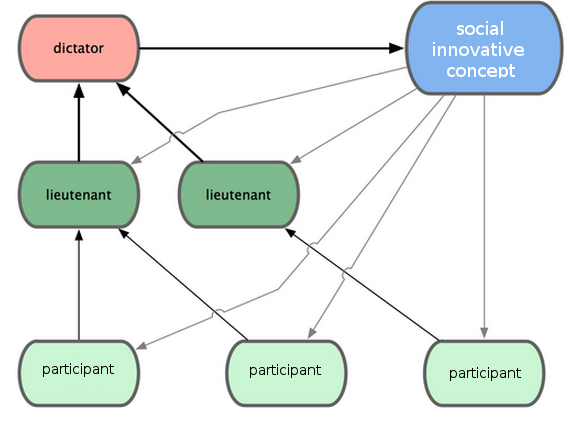Healthy & Recyclable Social Innovation (selfaccelerating social innovation accelerator vol2)
June 01, 2016
Terminology:
- OPENSOURCE: tools and products which both business- and non-businessworld can use & modify
- SIC: social innovative concept
- RESTAPI: popular way to distribute and share online data
- BOTTOM-UP: Team members are invited to participate in every step of the management process

The above illustrated cyclic flow (or parts of it) could happen thru human interaction and/or software. Therefore, a house with people could also simply represent a database.
Allow small-scale dictatorship, to prevent big-scale dictatorship
Ideally a healthy SIC would need at least 2 participants to prevent dictatorship or hierarchy. The more we think of SIC’s in terms of failure/success, the more so-called ‘experts’/dictatorship/hierarchy will arise in a SIC’s:

In softwareworld, dictatorship is allowed but in practice only works for very small projects/components. As the participants (Developers) grow, the dictator will get flooded with communication & todos. Eventually the dictator will:
- become unresponsive
- and/or abandons the projects
- and/or will share upstream SIC activities with other participants
The dictator-experience is an experience every opensource software developer needs to experience. One would almost think that, in order to prevent dictatorship, everybody should be allowed to try to be a dictator.
Participants as a currency/metric
When participants of SIC’s get an equal personal budget (time/money/etc), SI is accelerated democratically. Each participant can decide on his/her own to either reinvent the wheel, be a dictator, or join similar minded SIC’s. Lets not dream away on how this would beautifully fit into a European base income-concept.
End of projects
Stop top-down projects, start co-creational SIC’s.
As much as we love to believe governments can support SI, a government has traditionally been a top-down apparatus. One could argue true top-down does not really exists, since in the end it always boils down to a network of people. However, budgets mostly get distributed top-down over groups of people, and for SIC’s this works counterproductive.
SI budgets should be spreaded over participants for a co-creational workflow, and acceleration of trust.
From Temporary to Durable innovation
- projects have an start and end
- but SIC’s have activity
SIC’s should be clusterable
- projects are seperated by time/budgets
- but SIC’s can cluster and/or recycle eachother regardless of time (see picture)

As you can see, a topology of open SIC’s will fully be able to re-use eachothers efforts. Projects however, can only re-use published data. See in the next article how licenses can accelerate trust.
Focusing on milestones instead of measuring elapsed time:
- projects measure progress in time
- but SIC’s could just focus on ‘its done when its done’
NOTE: It’s not a bad idea to use projects at all. Governments & people can still benefit a lot from projects. However, governments should distinct between projects and SIC’s: because if you only got one hammer, everything becomes a nail.
how SIC licences can keep SI accelerators healthy, and accelerate trust
Inspired by
This article has been greatly inspired by talks with the wonderful people of:
Credits: Arjan Biemans, Erna Bosschart, Bonno Pel, Kaat Peters, Liisa Joutsenjarvi, Christoph Grud, Ivan Kepecs, Oscar Racke, Anne Paavolainen, Peter Wolkowinski, Jonas Bylund, Peter van de Glind, and probably a lot of people I forgot.











 © 2022. All rights reserved by Leon van Kammen under this
© 2022. All rights reserved by Leon van Kammen under this